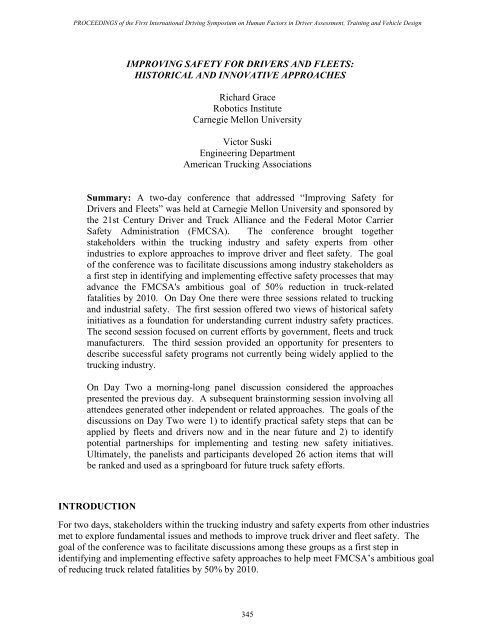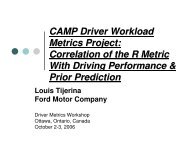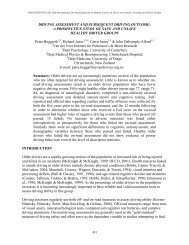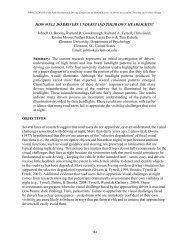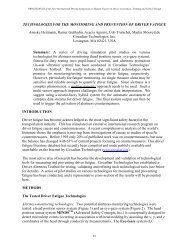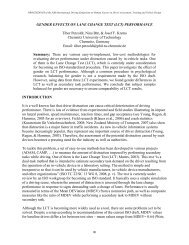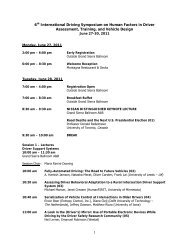IMPROVING SAFETY FOR DRIVERS AND FLEETS - Driving ...
IMPROVING SAFETY FOR DRIVERS AND FLEETS - Driving ...
IMPROVING SAFETY FOR DRIVERS AND FLEETS - Driving ...
You also want an ePaper? Increase the reach of your titles
YUMPU automatically turns print PDFs into web optimized ePapers that Google loves.
PROCEEDINGS of the First International <strong>Driving</strong> Symposium on Human Factors in Driver Assessment, Training and Vehicle Design<br />
<strong>IMPROVING</strong> <strong>SAFETY</strong> <strong>FOR</strong> <strong>DRIVERS</strong> <strong>AND</strong> <strong>FLEETS</strong>:<br />
HISTORICAL <strong>AND</strong> INNOVATIVE APPROACHES<br />
Richard Grace<br />
Robotics Institute<br />
Carnegie Mellon University<br />
Victor Suski<br />
Engineering Department<br />
American Trucking Associations<br />
Summary: A two-day conference that addressed “Improving Safety for<br />
Drivers and Fleets” was held at Carnegie Mellon University and sponsored by<br />
the 21st Century Driver and Truck Alliance and the Federal Motor Carrier<br />
Safety Administration (FMCSA). The conference brought together<br />
stakeholders within the trucking industry and safety experts from other<br />
industries to explore approaches to improve driver and fleet safety. The goal<br />
of the conference was to facilitate discussions among industry stakeholders as<br />
a first step in identifying and implementing effective safety processes that may<br />
advance the FMCSA's ambitious goal of 50% reduction in truck-related<br />
fatalities by 2010. On Day One there were three sessions related to trucking<br />
and industrial safety. The first session offered two views of historical safety<br />
initiatives as a foundation for understanding current industry safety practices.<br />
The second session focused on current efforts by government, fleets and truck<br />
manufacturers. The third session provided an opportunity for presenters to<br />
describe successful safety programs not currently being widely applied to the<br />
trucking industry.<br />
On Day Two a morning-long panel discussion considered the approaches<br />
presented the previous day. A subsequent brainstorming session involving all<br />
attendees generated other independent or related approaches. The goals of the<br />
discussions on Day Two were 1) to identify practical safety steps that can be<br />
applied by fleets and drivers now and in the near future and 2) to identify<br />
potential partnerships for implementing and testing new safety initiatives.<br />
Ultimately, the panelists and participants developed 26 action items that will<br />
be ranked and used as a springboard for future truck safety efforts.<br />
INTRODUCTION<br />
For two days, stakeholders within the trucking industry and safety experts from other industries<br />
met to explore fundamental issues and methods to improve truck driver and fleet safety. The<br />
goal of the conference was to facilitate discussions among these groups as a first step in<br />
identifying and implementing effective safety approaches to help meet FMCSA’s ambitious goal<br />
of reducing truck related fatalities by 50% by 2010.<br />
345
PROCEEDINGS of the First International <strong>Driving</strong> Symposium on Human Factors in Driver Assessment, Training and Vehicle Design<br />
On Day One there were three sessions dedicated to trucking and industrial safety. The<br />
presentations in the first session provided a foundation for understanding traffic safety practices<br />
from two unique perspectives. The presentations in the second session focused on current safety<br />
efforts by government, fleets and truck manufacturers. The third session provided an<br />
opportunity for presenters to describe successful safety programs not currently being widely<br />
applied to the trucking industry.<br />
On Day Two a morning-long panel discussion addressed the approaches presented on the<br />
previous day and resulted in a group brainstorming session to develop new or related approaches.<br />
The goal of the panel discussion and brainstorming session was to identify practical safety steps<br />
that can be applied by fleets and drivers now and in the near future. The participants in the<br />
brainstorming session generated a list of 26 action items. The 21 st Century Driver and Truck<br />
Alliance will use these action items as a baseline for continuing these important conversations<br />
among fleets, government and researchers.<br />
ESTABLISHING COMMON GROUND<br />
Dr. Leonard Evans, President of Science Serving Society, and Dr. Nicolas Ward, Director of the<br />
ITS Institute Human Factors Research Laboratory at the University of Minnesota, opened the<br />
conference on Day One by presenting their differing views of historical crash data. Dr. Evans'<br />
presentation “Major Factors Relating to Highway Safety” focused on four major factors<br />
pertaining to highway safety: 1) roadway and traffic engineering; 2) automotive engineering; 3)<br />
driver behavior and 4) driver performance. Dr. Ward's presentation “Human Factors and Stable<br />
Systems: Can Technology Deliver What it Promises” addressed Intelligent Transportation<br />
Systems (ITS) as potential aids to traffic safety but only when there are realistic expectations, a<br />
human-centered approach and an understanding of the risks and consequences.<br />
While each presenter emphasized different points and perspectives throughout their<br />
presentations, they came to the same conclusion. Both identified the driver, and primarily driver<br />
behavior, as the key to improving traffic safety. This is an example of finding common ground<br />
among seemingly different ideas and that is the mission of the 21 st Century Driver and Truck<br />
Alliance.<br />
ONGOING EF<strong>FOR</strong>TS<br />
There were other opportunities during the first day, and throughout the rest of the conference, for<br />
participants to express their ideas in a politically neutral and positive environment. Even those<br />
who have historically differed in their opinions or those who have not previously had an<br />
opportunity to express their ideas were able to find their voice and move toward common<br />
understandings and goals. Six speakers from government, truck manufacturers, fleets and<br />
research organizations presented information about ongoing safety programs within the trucking<br />
industry. Two of these presentations are highlighted below as examples of the quantitative<br />
results that can be achieved through the application of specific safety programs.<br />
346
PROCEEDINGS of the First International <strong>Driving</strong> Symposium on Human Factors in Driver Assessment, Training and Vehicle Design<br />
1. Barton and Tardif reported the benefits of incentive programs introduced into two<br />
Canadian fleets. One fleet reported a reduction in driver turnover from 98% to 20%<br />
between 1998 and 2000. A second fleet reported a reduction from 80% to 30% between<br />
199 and 2001. Significant improvements in safety were also seen. Reportable incidents<br />
dropped by 33% over the course of the study. (For more information, refer to the<br />
conference proceedings.)<br />
2. McFann presented the results of a regional training tour at North American Van lines that<br />
was undertaken in the spring of 1999. It was conducted at 14 company locations with<br />
350 drivers and/or staff attending. Vehicular training consisted of the North American<br />
Driver Awareness Course and the option of taking a check ride with an instructor and<br />
driving a truck simulator. Of the 350 participants, 55 participated in both vehicular<br />
programs and drove the simulator. After driver training, preventable crashes dropped by<br />
50%. (For more information, refer to the conference proceedings.)<br />
NEW PERSPECTIVES<br />
Three speakers used the third session on Day One to present thoughts outside of the industry<br />
regarding new directions for future programs. One of the presenters, Jack Balsamo, spoke about<br />
“Turning Concepts Into Reality: Practical Issues in Implementing Behavior Based Safety”. He<br />
detailed a mature methodology for positive behavioral change. He identified three items that<br />
influence and control behavioral decision-making:<br />
• Antecedents<br />
• Behavior itself<br />
• Consequences<br />
Studies have shown that influencing antecedents holds the greatest promise for changing<br />
behavior. The mechanism for employing behavior-based performance improvement is four-fold.<br />
Balsamo then defined a four-step methodology based on this conclusion that lead to positive<br />
improvements:<br />
• Identify critical behaviors<br />
• Gather data<br />
• Provide feedback<br />
• Use data to remove barriers<br />
This methodology has been used in a variety of industries to improve safety. (For more<br />
information, refer to the conference proceedings.)<br />
347
PROCEEDINGS of the First International <strong>Driving</strong> Symposium on Human Factors in Driver Assessment, Training and Vehicle Design<br />
EVERYONE HAD A VOICE<br />
The other presentations from Day One were equally compelling as the ones highlighted in this<br />
paper. Their titles are listed below and the abstracts, papers and slides are available in the<br />
conference proceedings.<br />
Dr. Ron Knipling, Chief of the Research Division,<br />
FMCSA<br />
"Changing Driver Behavior Through On-Board Safety<br />
Monitoring"<br />
Bill Gouse, Executive Engineer, Technology<br />
Planning, Freightliner LLC<br />
"Intelligent Vehicle Driver Assistance Systems"<br />
Thomas R Tray, Marsh Transportation Group<br />
"Risk Management: Managing Safety and Loss Control<br />
and Much More"<br />
Ray Barton, President, Ray Barton Associates,<br />
Louis-Paul Tardif, President, L. P. Tardif and<br />
Associates<br />
"Implementing Successful Incentive Programs Within<br />
Transport Fleets"<br />
K. Don Tullos C.D.S., Sr. Corporate Safety Advisor,<br />
FedEx Express<br />
"FedEx Express - Four Steps of Safety"<br />
A FOCUSED COLLECTIVE EF<strong>FOR</strong>T<br />
348<br />
John H. McFann, Project Administrator, North<br />
American Van Lines, Inc.<br />
"Back to Basics with High Technology"<br />
Jack Balsamo, Principal Consultant, Behavioral<br />
Science Technology<br />
"Turning Concepts Into Reality: Practical Issues In<br />
Implementing Behavior Based Safety"<br />
Robert M. Braswell, Technical Director, TMC<br />
"Explorations Into Positive Reinforcement<br />
Technique Using IVI Technology forImproving<br />
Driver Behavior"<br />
Victor Suski, Senior Automotive Engineer,<br />
American Trucking Associations, Inc.<br />
"Highway Safety and Reliable Systems: We Have<br />
Met the Enemy and He is Us"<br />
After a brief recap, a morning-long panel session based on information presented the previous<br />
day, provided an opportunity for continued discussions on Day Two. These discussions led to a<br />
group brainstorming session where participants generated a list of action items for industry<br />
implementation.<br />
The panelists generally agreed on the following points during the panel discussion:<br />
Industry should view truck drivers more as pilots to encourage the mindset that truck drivers<br />
are fundamentally different in terms of skill requirements from personal use vehicle drivers.<br />
The “No Zone” program sponsored by the U.S. Department of Transportation is a good<br />
example of safety outreach programs. Carriers need to develop similar outreach programs.<br />
More should be done to attract young people to a career as a driver. Image and<br />
professionalism are two important elements. Programs should be launched to recruit young<br />
drivers from new population segments that historically have avoided the profession.<br />
Money is an important factor. The ability to pass costs along to a consumer base is an<br />
important consideration, going back to the general public’s attitude toward transportation<br />
costs and risks. Money in our society establishes “worth” for better or worse and therefore<br />
impacts professional outlook.
PROCEEDINGS of the First International <strong>Driving</strong> Symposium on Human Factors in Driver Assessment, Training and Vehicle Design<br />
Career satisfaction is an important factor for driver retention. Driver considerations are<br />
important. Companies should consider: 1) giving drivers phone calls home; 2) giving meal<br />
compensation above industry norm; 3) doing things to affect change in the driver lifestyle<br />
and 3) treating drivers as one would treat other employees on travel for business. These<br />
actions may help attract drivers to the profession.<br />
Companies should encourage drivers to go back to school for continuing education.<br />
Companies should consider mandated vacation time to help foster driver well being.<br />
Vacation can help reduce work stress thereby producing improved safety outcomes.<br />
(European communities, for example, have 30-days of mandated vacation time).<br />
During the subsequent brainstorming session, panelists and attendees together developed 26<br />
action items that have been loosely organized into five categories: program, research, outreach,<br />
cooperative action and political action. A sampling of the main action items from each category<br />
include:<br />
Program: Develop programs for management to encourage driver participation in<br />
developing safety programs.<br />
Research: Establish real-time feedback systems for drivers, define good behaviors,<br />
reward mechanisms.<br />
Outreach: Establish voluntary national standards for driver training, relying on<br />
incentives for implementation by industry.<br />
Cooperative Action: Provide outreach to shippers and ultimate customers to help develop<br />
solutions to safety issues. Make presentations/booklets to reach these<br />
communities.<br />
Political Action: Work together for elimination of 12 percent excise tax on safety-related<br />
equipment. (For a complete list of action items, contact the authors of<br />
this report.)<br />
CONCLUSIONS<br />
This conference is only the beginning of the effort to focus on the driver as the key for improving<br />
safety and productivity within the trucking industry. The 21 st Century Driver and Truck Alliance<br />
will continue to mediate discussions among stakeholders regarding these goals. The next step in<br />
the process of following up on the proposed action items has already begun. Action items have<br />
been and will continue to be refined and expanded through continuous interaction with trucking<br />
stakeholders. The proposed steps in this task are:<br />
• Distribute the action items to the conference attendees for clarification. Additional action<br />
items can be added at this time.<br />
• Distribute the final action items to the attendees for a ranked vote. Each attendee will be<br />
asked to select the five action items for which he/she has the most interest.<br />
• The votes will be tabulated and redistributed to the attendees.<br />
• Sponsors will be sought to organize working groups for the top ranked action items.<br />
• Those who were unable to attend the conference but who are interested in being a part of this<br />
important work will also be invited to join the working groups.<br />
349
PROCEEDINGS of the First International <strong>Driving</strong> Symposium on Human Factors in Driver Assessment, Training and Vehicle Design<br />
The 21 st Century Driver and Truck Alliance will work with industry stakeholders to evolve these<br />
workshops into industry lead programs that make a significant difference in trucking safety and<br />
productivity.<br />
ACKNOWLEDMENTS<br />
This conference was sponsored by the 21 st Century Driver and Truck Alliance with financial<br />
support from the Federal Motor Carrier Safety Administration and those who attended the<br />
conference.<br />
350


